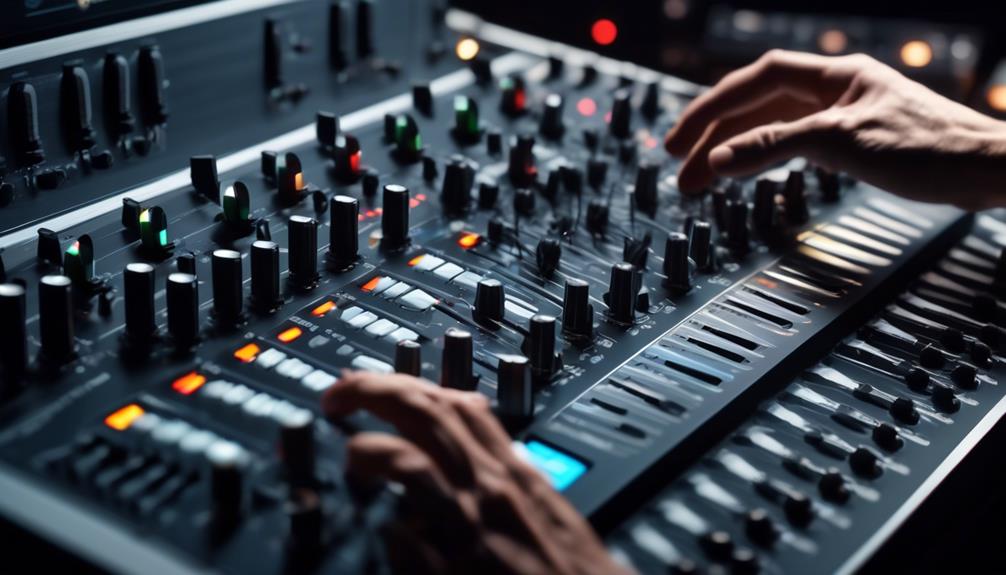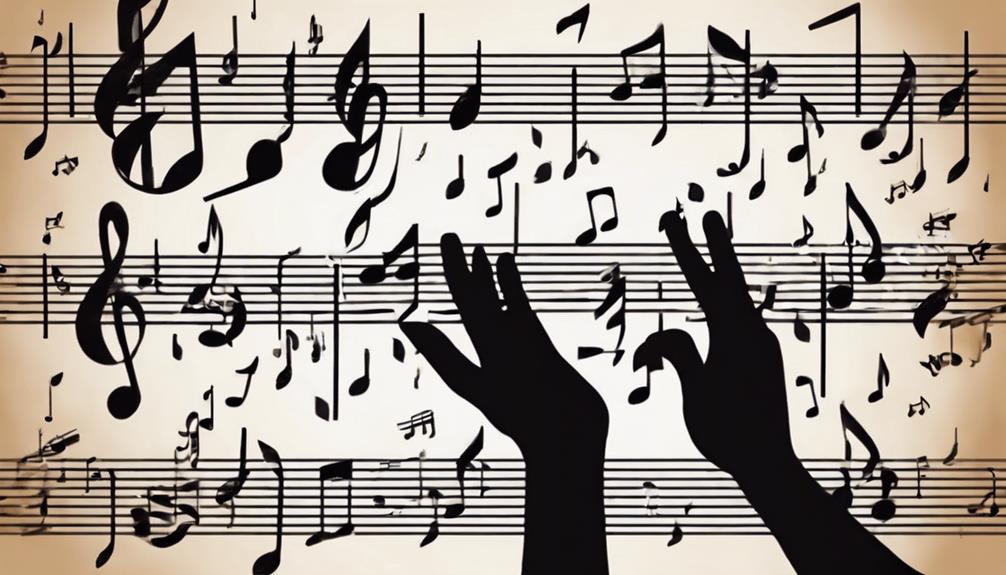No products in the cart.
Imagine you’ve just laid down a killer drum track in your home studio, but something’s off; the bass line isn’t meshing with your beats as smoothly as you’d hoped. You’re not alone in this struggle—many home studio enthusiasts encounter similar hurdles.
By grasping basic music theory, you’ll unlock the secrets to why certain notes and rhythms click, and others clash, helping you to craft harmonious and compelling music. Understanding the building blocks of music—scales, chords, and progressions—not only refines your ear but also streamlines your creative process, making your studio time more efficient and enjoyable.
So, let’s consider how a little theory can go a long way in enhancing your home recordings. Stick around to uncover the practical benefits that basic music theory brings to the table, and how it can transform your home productions from disjointed sounds into cohesive masterpieces.
Key Takeaways
- Understanding basic music theory enhances the overall quality of music produced in home studios.
- Knowledge of scales, intervals, and key signatures allows for more creative improvisation and composition.
- Grasping chord progressions and harmonic movement helps create emotional impact and engaging soundscapes.
- Learning music theory promotes effective communication and collaboration in the home studio environment.
Understanding Melodic Construction

To construct a melody that resonates, you’ll need to understand the relationship between scales, intervals, and chord progressions. Scales provide the foundation for melodic construction, offering a palette of notes from which you can draw. They set the tonal mood, whether you’re aiming for a cheerful major sound or a more introspective minor tone.
Intervals, the distance between notes, are the building blocks of melody. They convey the emotion and tension within your musical line. Mastering the use of intervals allows you to sculpt the contour of your melody, giving it peaks and valleys that capture the listener’s ear.
Chord progressions act as the backbone of your tune, supporting your melodic phrases. A well-crafted progression can inspire melodic improvisation, as you experiment with notes that fit within or playfully clash against the chords. This is where innovation thrives, as you explore unconventional harmonies that challenge and excite your audience.
Incorporating melodic variation keeps your music dynamic and engaging. By varying the rhythm, pitch, or articulation of a melodic idea, you breathe new life into your themes. This approach ensures that your melodies remain fresh and compelling, holding your listener’s attention throughout your sonic journey.
The Role of Harmony
Having explored the framework of melodic construction, let’s now examine how harmony enriches your musical creations by layering pitches that resonate together.
Harmony isn’t just a backdrop; it’s the canvas that allows your melodies to stand out. Mastering the art of harmony in your home studio will elevate your music, giving it the depth and fullness it deserves.
Consider these key points:
- Harmony nurtures the mood: It’s the difference between a flat, one-dimensional sound and a rich tapestry that captivates the listener’s emotions.
- Chord progressions define the journey: They take your listeners through an auditory story of tension and release.
- Harmonic balance is crucial: Too much complexity, and your music may sound chaotic; too little, and it might feel empty.
- Harmonizing vocal arrangements: This can transform a simple melody into a profound musical statement, showcasing the importance of harmony in creating a memorable track.
You’re aiming for innovation, so understanding harmony is non-negotiable. It’s the hidden force that can make your music resonate on a deeper level. By grasping the role of harmony, you’ll be crafting soundscapes that aren’t just heard—they’re felt.
Rhythmic Foundations Explained


Rhythmic foundations, the heartbeat of your music, dictate the pace and groove that engage your listeners from the first beat to the last. Understanding rhythm isn’t just about keeping time; it’s about sculpting the energy flow of your tracks. You’ll find that mastering beat patterns is a cornerstone of creating compelling music.
Beat patterns are the architects of your song’s time signature. They’re the repeatable backbones that give your music consistency and structure. Dive into these patterns, and you’ll discover groove essentials—those magical elements that make your listeners nod their heads or tap their feet. It’s about the placement of notes and silences, the accents, the dynamics, and the tempo.
To innovate, start by dissecting rhythms in music that moves you. Identify what patterns are used and how they interact with melody and harmony. Experimentation is key. Try shifting accents, playing with syncopation, or even creating polyrhythms to add complexity. Your home studio is your laboratory for rhythmic exploration.
Decoding Chord Progressions
As you explore chord progressions, you’ll learn to recognize the relationships between chords and how they guide the listener through a musical journey. Grasping these patterns is key to building a solid harmonic foundation for your tracks, ensuring each chord supports the next seamlessly.
Understanding Chord Relationships
Unlocking the secrets of chord progressions can transform your home studio’s music from simple melodies to complex, emotive landscapes. Understanding chord relationships is central to this transformation, enabling you to craft music that resonates with your listeners.
Here’s how you can start:
- Grasp the importance of chord voicings: Different voicings can color your music with varied emotional hues.
- Master utilizing chord inversions: They offer a smooth flow and transition between chords.
- Create compelling harmonic movement: Recognize patterns that serve as the backbone of countless hits.
- Design balanced soundscapes: Apply theory for a harmonically rich mix.
Dive into this knowledge to innovate and elevate your home studio’s output, ensuring every chord strikes a chord with your audience.
Building Harmonic Foundations
Delving into chord progressions is the cornerstone of building harmonic foundations in your home studio, setting the stage for more intricate and engaging musical creations. By mastering chord progression techniques, you’re not just playing chords; you’re weaving stories. Harmonic analysis techniques enable you to dissect and understand these narratives, ensuring your tracks have a coherent structure that resonates with listeners.
| Emotion | Chord Progression |
|---|---|
| Joy | I – IV – V – I |
| Sadness | i – VI – III – VII |
| Tension | i – V – VI – V |
| Release | IV – I – V – I |
With this knowledge, you can craft catchy hooks and melodies that stick. You’ll arrange your music with confidence, creating sounds that are not only harmonically rich but also balanced, thus enhancing the sonic quality of your productions.
Creating Emotional Impact
Building on your understanding of chord progressions, you’ll now explore how to harness these sequences to invoke specific emotions and create a powerful emotional impact in your music.
Chord progressions are the backbone of emotional storytelling in songs, and by exploring tonalities, you can craft a soundscape that truly resonates with listeners.
- Analyze the mood: Match chord progressions with the sentiment you want to express.
- Contrast dynamics: Use tension and release to enhance emotional depth.
- Experiment with modulations: Shift keys to inject surprise or intensify feelings.
- Study successful tracks: Learn how analyzing lyrics and their underlying chords can inform your own creations.
Scales and Key Signatures
Exploring scales and key signatures is crucial to mastering the composition and production of music in your home studio, as they form the blueprint for crafting melodies and harmonies that resonate with listeners. Grasping these concepts not only enhances your improvisation techniques but also equips you with transposing methods essential for adapting your music to different contexts and instruments.
Scales provide the vocabulary for your musical language. They’re the sequential arrangement of notes that set the mood and tonality for your tracks. When you understand scales, you’re able to create melodies that flow naturally and harmonies that enrich your compositions. Each scale, whether major, minor, or modal, offers a distinct emotional palette for you to paint with sounds.
Key signatures define the tonal center of your creations and dictate the use of sharps and flats. They’re your roadmap to maintaining consistency in pitch throughout a piece. With a firm knowledge of key signatures, you can ensure your tracks have a solid, coherent foundation, enabling you to produce music that’s both complex and captivating.
Enhancing Song Dynamics


Having mastered scales and key signatures, you’re now ready to breathe life into your music by incorporating dynamic variations that can transform a flat arrangement into an emotional journey. Dynamics aren’t just volume changes; they’re the heartbeats of your songs, essential for conveying emotion and keeping your listeners engaged.
Here’s how understanding basic music theory can enhance your song dynamics:
- Crafting Peaks and Valleys: Use music theory to build tension and release, creating an ebb and flow that captivates your audience.
- Emotional Storytelling: Dynamics can illustrate your song’s narrative, with crescendos for climactic moments and diminuendos for softer, more intimate parts.
- Contrast and Interest: Varying dynamics keep your tracks interesting, preventing monotony and maintaining listener engagement.
- Live Performance Energy: Utilizing dynamics in live performances ensures that every show is unique, showcasing your ability to connect with the audience on the spot.
Understand that the influence of dynamics on listener engagement can’t be overstated. They make your music breathe and grow, allowing each listener to experience your creation as if it were a living entity.
With this knowledge, you’ll not only craft songs that resonate on a deeper level but also ensure each home studio recording is a stepping stone to memorable performances.
Arrangement and Orchestration Basics
As you venture into arrangement and orchestration, you’ll learn to shape the structure of your music, ensuring each section flows seamlessly into the next.
You’ll discover how to define the roles of various instruments and how their interactions can enhance the overall texture of your compositions.
Grasping these basics is crucial for you to create pieces that resonate with balance and evoke the intended emotional response from your listeners.
Crafting Cohesive Song Structures
To craft cohesive song structures in your home studio, you’ll need to grasp the basics of arrangement and orchestration, ensuring each musical element contributes to a seamless and compelling composition. By exploring musical genres and utilizing technology advancements, you can enhance your creative toolkit.
Here’s what you should focus on:
- Harmonic Progressions: Create emotional landscapes by mastering chord changes and transitions.
- Melodic Contours: Weave melodies that captivate and tell your song’s story.
- Rhythmic Diversity: Inject energy and flow by varying beats and rhythmic patterns.
- Instrumental Textures: Choose sounds that complement and enrich your musical canvas.
These elements are the building blocks for songs that resonate with listeners, keeping them engaged from start to finish.
Instrument Roles and Interactions
In the symphony of home studio production, understanding the roles and interactions of different instruments is key to crafting a balanced and dynamic musical arrangement. By delving into orchestration basics, you’ll learn how to use instrument texture and instrumental layering to convey emotions and enhance the track’s overall sound.
Recognizing how instruments interact allows for more engaging compositions, ensuring each element complements the others rather than clashing or muddying the mix.
Your grasp of instrument roles enables purposeful musical decisions, transforming a good production into a great one. Mastering these basics isn’t just about technicality; it’s about elevating your home studio’s output to professional echelons.
Invest time in learning these principles, and watch as your arrangements bloom with clarity and innovation.
Collaborative Workflow Benefits


When you collaborate with someone who has a firm grasp of music theory, your home studio productions can reach new heights of creativity and technical excellence. Improving collaboration between musicians and producers becomes much simpler when everyone speaks the same musical language.
Music theory isn’t just about following rules; it’s about enhancing creativity by giving you the tools to understand why certain sounds work well together. Here’s how a basic understanding of music theory can benefit your collaborative workflow:
- Enhanced Communication: You’ll be able to articulate your musical ideas clearly, leading to efficient sessions and more time for experimentation.
- Creative Problem-Solving: When creative blocks occur, music theory serves as a guide to overcome them, keeping the collaborative process flowing.
- Genre Flexibility: Knowledge of theory allows you and your collaborators to easily adapt to and create within a variety of musical styles.
- Quality Control: With a theory background, you can ensure that the musical elements in your production are harmonically and melodically compatible.
Learning music theory equips you with a shared vocabulary and a deeper understanding of music, which is invaluable when aiming for innovation in your home studio collaborations.
Frequently Asked Questions
Should I Learn Music Theory for Music Production?
You should learn music theory to enhance your production skills, enabling creative experimentation and genre blending through a deeper understanding of melody, harmony, and rhythm, crucial for innovative and polished musical creations.
What Are the Benefits of Learning Music Theory?
You’ll grasp chord progressions and melodic construction, fueling innovation in your compositions. It sharpens your creative edge, making your musical experimentation coherent and your collaborative efforts more seamless.
Why It Is Important to Know the Basic of Music?
You’ll unlock vast sound exploration without creative limits by knowing music basics, shaping innovative mixes that resonate and captivate, fostering unique expressions that stand out in an ever-evolving, competitive musical landscape.
Why Do You Need Music Theory?
You need music theory to master chord progressions and rhythmic patterns, which will elevate your compositions and help you innovate within any musical genre, ensuring your tracks stand out.
Conclusion
You’ve now grasped music theory’s essentials, empowering you to craft melodies, harmonize with confidence, and groove with solid rhythm.
You can decode chord progressions, navigate scales, and utilize key signatures to enrich your home studio creations.
Understanding dynamics, arrangement, and orchestration sets your music apart, while also streamlining collaborations.
With these tools, you’re well-equipped to turn your musical visions into realities.
Keep exploring — every new concept mastered is a step toward sonic brilliance.




